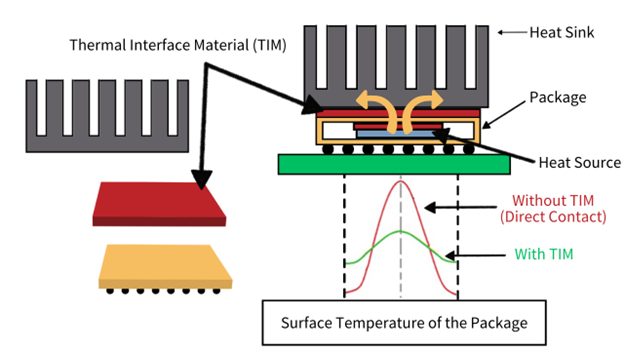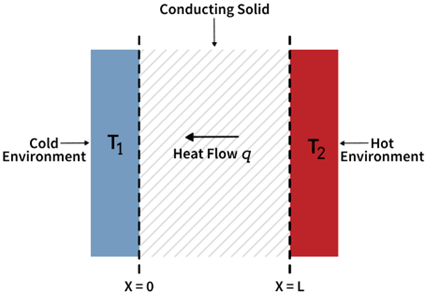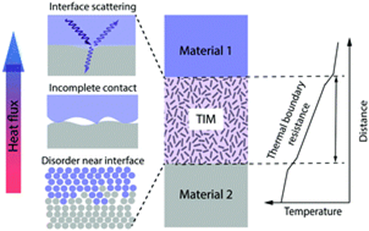Join us at the International Thermal Conductivity Conference (ITCC) and the International Thermal Expansion Symposium (ITES).
February 16, 2024
May 4, 2021
September 26, 2019
May 25, 2021
October 30, 2019

July 10, 2023
Thermal impedance and thermal conductivity are two critical material properties in the thermal interface material (TIM) selection process. TIMs, a unique group of thermally superior materials, act as passive heat transporters in complex electronic devices like light-emitting diodes (LEDs) and computer processing units (CPUs). They transport excess heat from a highly thermal energetic area of an electronic device towards a heat sink or dissipater, preventing damage or malfunction due to overheating.
The performance of a material as a TIM directly relates to its thermal conductivity and thermal impedance. Understanding these heat-exchanging processes is essential to determine the full potential of these materials in protecting electronic devices from overheating.

Figure 1: Diagram describing the function of a Thermal Interface Material and its impact on temperature regulation.
In this article, we delve into the definitions, characteristics, and applications of thermal conductivity and thermal impedance. We highlight their differences and how each unique property reflects a material’s role in the thermal management of electronic devices.
Although it represents only half of the equation in describing a thermal interface material’s performance, thermal conductivity is an incredibly widely used metric across a range of industries for describing the ability of a material to conduct heat. Thermal conductivity occurs due to molecular movement and agitation without any of the actual material moving.
The thermal conductivity of a material depends on several factors including the temperature gradient (the temperature difference between the object at a higher temperature vs one at a lower temperature), molecular and atomic material properties, and the length of the path that the heat travels before it is interrupted by another solid of a different conductivity value.

Figure 2: Visual representation of conductive heat transfer between two materials of various thermal compositions
The thermal conductivity of a material is denoted in watts per meter kelvin W/(m/K). Materials and substances classified as ‘good conductors’, such as copper and aluminum, display a thermal conductivity value in the range of 200-400 W/(m/K). Poor conductors are often gases or highly porous materials including atmospheric air, which has an extremely low thermal conductivity of roughly 26 W/(m/K).
Air is often incorporated into thermally insulative substances such as Styrofoam and building insulation to prevent the movement of heat through them. Thermal conductivity is a critical material property and is independent of the size, shape or thickness of a material as it is primarily determined by the effectiveness of heat transfer due to random molecular motion across a temperature gradient.
Thermal conductivity is measured following two main techniques: the steady-state method, and the transient methods. The selection of a measurement method is highly dependent on the type of material being tested. Thermtest offers a number of different devices that can test thermal conductivity following the procedure emphasized in both methods. Some of these devices include the heat flow meter and the transient line method, both of which provide R-value readings with an extremely high level of accuracy.
| Material | Thermal Conductivity (W/m·k) |
| Silver | 406 |
| Copper | 385 |
| Gold | 314 |
| Brass | 109 |
| Aluminum | 205 |
| Iron | 70.5 |
| Steel | 50.2 |
| Lead | 34.7 |
| Ice | 1.6 |
| Glass | 0.8 |
| Water at 20° C | 0.6 |
| Wool Felt | 0.04 |
| Styrofoam | 0.033 |
| Wood | 0.12-0.04 |
| Air at 0° C | 0.024 |
Figure 3: Table depicting various thermal conductivity values of common materials. Source: https://sciencing.com/thermal-conductivity-definition-units-equation-example-13722758.html
To understand thermal impedance, it is helpful to have a brief understanding of thermal resistance or the inverse of thermal conductivity. Thermal resistance reflects a material’s ability to resist the passing of heat through it and directly relates to the thickness of the material. The same holds true in the case of Thermal interface materials with thicker TIMs transferring heat more efficiently than thinner ones.
Contact resistance is another important material property to consider when discussing TIMs and is specific to the interfaces where a TIM meets a heat-generating component of a heat sink. Since it is near impossible for these components to lie directly flat on top of one another, there will always be several different voids and crevices present between the two materials that reduce the full effectiveness of the heat transfer. The presence of small spaces and air gaps between the two materials impacts the amount of contact resistance they have because air is an extremely poor thermal conductor.

Figure 5: Diagram depicting the impact of contact resistance on thermal impedance and heat transfer between two materials of different temperatures. Source: https://pubs.rsc.org/en/content/articlelanding/2020/tc/c9tc05415d
Thermal impedance is the total of all the combined thermal resistance and contact resistance values. A material with a high thermal impedance is a poor conductor of heat due to the higher thermal resistance and contact resistance the material possesses. This is likely due to a number of factors preventing the transfer of heat including surface roughness, clamping pressure, presence of an adhesive, non-homogeneity of a material and thickness. Since thermal impedance accounts for a range of various physical factors, it, therefore, paints a more holistic representation of how a material acts as a facilitator or barrier to the passing of heat in an electronic device.
When comparing the effectiveness of a thermal interface material, it is more realistic to compare the thermal conductivity and thermal impedance of a material instead of simply restricting material property analysis to thermal resistance, thermal impedance, or thermal conductivity alone. Especially in the case of more complex electronics, poor thermal regulation and TIM performance can be detrimental to the successful operation of the device. Understanding the key characteristics and measurement processes of both thermal impendence and thermal conductivity can help ensure an electronic device remains safe to operate and is not at risk of experiencing damaged as a result of poor heat transfer and internal temperature regulation.
Chapline, G., Rodriguez, A., Snapp, C., Pessin, M., Bauer, P., Steinetz, B., & Stevenson, C. (n.d.). Thermal Protection Systems. 18.
Coatings, A. (2019, April 30). Understanding The Difference Between Thermal Impedance And Thermal Conductivity | A&A Thermal Spray Coatings. A&A Coatings. https://www.thermalspray.com/understanding-the-difference-between-thermal-impedance-and-thermal-conductivity/
How Heat Sinks Work. (2010, August 31). HowStuffWorks. https://computer.howstuffworks.com/heat-sink.htm
Thermal Conductivity of Water and Steam | Value | nuclear-power.net. (n.d.). Nuclear Power. Retrieved May 6, 2021, from https://www.nuclear-power.net/nuclear-engineering/heat-transfer/thermal-conduction/thermal-conductivity/thermal-conductivity-of-water-and-steam/
Thermal Interface Materials. (n.d.). Laird Performance Materials. Retrieved June 23, 2023, from https://www.laird.com/knowledge-center/thermal-interface-materials
What is Thermal Conductivity? An Overview. (n.d.). Thermtest. Retrieved June 23, 2023, from https://thermtest.com/what-is-thermal-conductivity